| ART STORAGE FOR PRINTED MATTER AND PAINTINGS
|
 |
|
Practicing proper maintenance and storage of art is necessary for the longevity of all artworks, from priceless oil paintings to sentimental family portraits. There are a variety of environmental and material quality concerns that can negatively impact the lifespan of a piece. The museum and professional art worlds utilize a wide array of storage options specific to each type of artifact and art object which can also be implemented in the home to ensure the long-term protection of your collection.
The following article discusses the recommended storage options for paper printed matter and paintings on canvas, with suggestions of how they may be adapted to fit individual needs. |
Summary
| Storage Environment |
Printed Matter |
Paintings |
- Dry spaces with good air circulation
- Relative humidity 50%
- Temperature 21°C or 69°F
- No direct UV light or open fluorescent bulbs
|
- Interleaving
- Folders
- Encapsulation
- Hinged mats
- Frames
- Solander boxes
- Map cabinets and drawers
- Steel horizontal shelving
|
- Off the floor
- Skid-proof pads
- Slotted shelves
- Polyester curtains
- Sliding screens
- Store flat
|
|
| Storage Environment
|
 |
|
Due to the atmospheric and environmental effects on artworks, as discussed in our article on conservation framing, selecting the appropriate room for storage is the first step to safely store your art. It is advised against using an attic or basement as a storage space because of the potential of flooding and roof leaks. Additionally, the concern of high temperatures and humidity in an attic space accelerates the deterioration process of paper prints and paintings.
Specifically for paper prints, relative humidity (RH) above 60% accelerates both chemical and biological deterioration and paper distortion. Similarly for paintings, RH above 60% encourages the growth of mould, while RH below 35% can cause paint to become brittle and prone to cracking, lifting paint and eventual paint loss.
Because of this, leading institutions maintain relative humidity at around 50%. Temperatures are advised to be at around 21°C or 69°F.
Humidity is affected by both internal and external temperatures and it is therefore advised to select a climate-controlled area for storage. You can test the humidity level of your space using a hygrometer; some homes have pre-installed hygrometers, however these can also be purchased from your local hardware store. Maintaining the appropriate RH can be achieved by adjusting spatial heating, the use of a humidifier, and proper ventilation.
Caution must be taken not to place the art near the heat source and humidifier/vent as close proximity to these will adversely affect the pieces you want to protect (this also includes your art currently on display!). In addition, it is best not to place art on the inside of an exterior wall as these experience temperature fluctuations and excessive moisture.
For how best to establish and maintain a climate-controlled space, consult your local heating and ventilation company.
Lighting is also an important consideration in the storage space. Do not store art in the path of direct UV light, or under an exposed fluorescent lamp as these will cause rapid colour fading.
To prevent harmful light leaking onto the art, you may choose to cover windows with blackout curtains and replace fluorescent lamps with LED bulbs, covering exposed bulbs with shades. Additionally, your chosen storage system may enclose your artworks, preventing extended light damage. Open and closed storage systems and apparatuses will be discussed further in this article. |
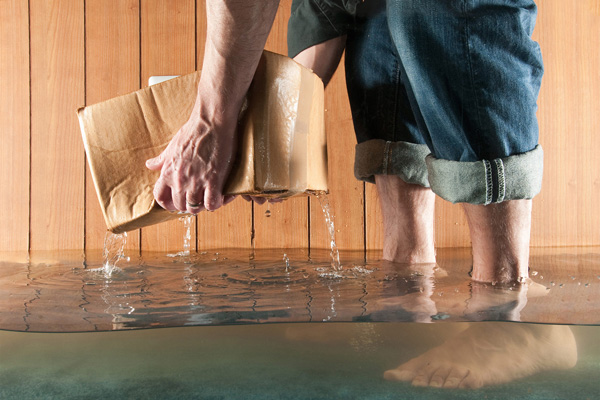
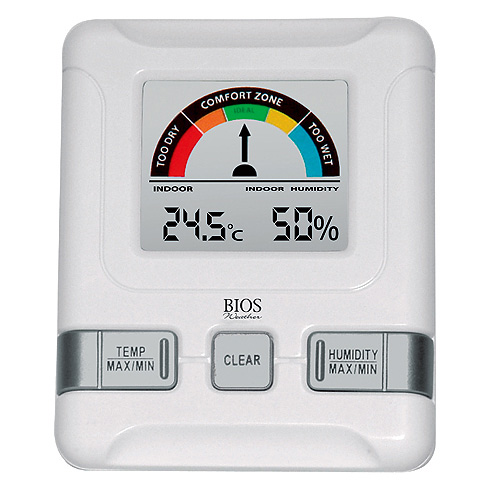
Digital hygrometer
|
| Printed Matter
|
 |
|
It is important to prepare your artwork prior to storage. In the case of printed matter, first remove any dust and dirt using a soft brush, taking care not to smudge or mark delicate charcoal, pastel, or chalk works. Be aware of plastic envelopes or sheeting, newspapers, acidic wrapping papers, cardboard mats or backings, dried adhesive tapes, metal fasteners, or other foreign substances which can contribute to the degradation of the artwork. When possible, remove foreign materials prior to storage unless their removal will affect the integrity of the piece. Substances which will permanently alter your printed matter (such as glue or tape residue) are not considered conservation quality and should be avoided.
The following are guidelines and considerations for the safe and proper storage of printed matter: |
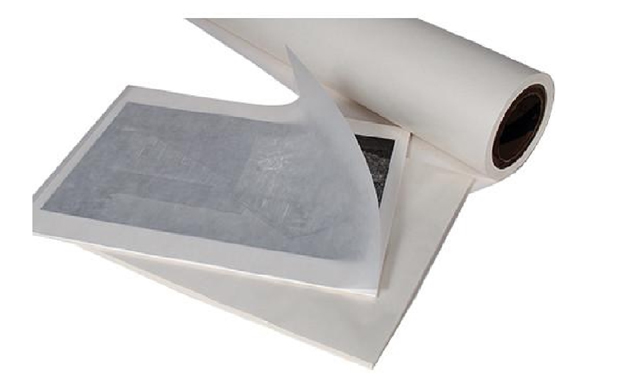
Interleaving
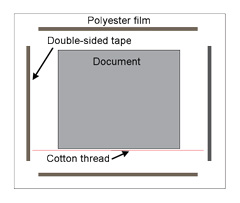
Encapsulation
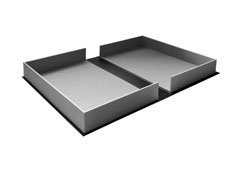
Solander Box
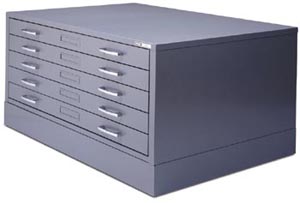
Map Cabinet
|
Materials
- Use only acid-free materials - neutral pH or alkaline buffered products.
- Conservation quality boards and papers are often described as "100% rag" by manufacturers.
- Inert polyester film (Mylar) can be used for folders, sheets, sleeves, and envelopes.
- Lightweight corrugated polypropylene sheets (Coroplast) may also be used.
Storage Recommendations
- Interleaving is the process of inserting blank acid-free pages between prints.
- Folders made of acid-free materials offer increased safety and support for each print.
- Encapsulation is a process in which artwork is sandwiched between two protective sheets of polyester film while the edges of the package are sealed off.
- Hinged mats with windows protect the image surface and reduce the risk of damage while handling.
- Framing a print with spacers prevents delicate media, like charcoal, from smudging. Read our full article on framing here.
- Solander boxes are strong, durable boxes with hinged backs that open flat. These can be used to store multiple prints of the same size. Solander boxes are usually made to fit the prints they contain to prevent unnecessary movement within the box.
- Steel, horizontal shelving can be used for framed prints placed vertically with cardboard sheets separating the frames to ensure they do not damage each other. Can also be used to store solander boxes.
- Map cabinets and shallow drawers are best for storing paper works that are interleaved, matted, or in a folder. They are also ideal for storing oversized prints. Cabinets and drawers are effective options to protect your work against dust and light.
|
| Paintings
|
 |
|
To prepare your paintings prior to storage, ensure the painting, especially the front surface, is clean. The soft surface of acrylic paints attract more dust and dirt than oil paints, therefore it is necessary to practice preventative care (rather than restorative care) with your artwork. Remove dust and dirt with a soft brush, preferably sable hair, gently moving once in the direction of the artist’s brush strokes, and then back again in the opposite direction.
Installing a backing board on a canvas painting will protect the painting from mechanical damage (ex: protrusions) on the reverse side, buffer fluctuations in relative humidity by enclosing the reverse of the painting, and increase the overall stability of the canvas and stretcher frame. If your painting does not come with a backing board, contact your local framer for installing custom-cut conservation quality boards to your canvas paintings.
Use the following recommendations to safely store your paintings: |
Storage Recommendations
- Keep paintings off the floor. Paintings should be raised at least 4 inches above the ground to protect against dust, dirt, or possible water accumulation.
- Skid-proof pads can be used to temporarily store paintings vertically stacked against a wall. Separate paintings with a cardboard sheet whose size is bigger than the larger of the two adjacent paintings. Face the outermost painting inward to avoid damage to the painting surface.
- Slotted multi-purpose storage shelves. These are available in many adjustable varieties such as open-ended vertical shelves to accommodate paintings of different sizes and open-ended horizontal shelves for damaged, or unframed artwork. Separate stacked paintings (as in the vertical slots) with cardboard sheets.
- Polyster sheeting can be draped over storage units to protect against dust. Make sure to allow for adequate air circulation.
- Sliding screens (also known as Picture Racks) are common storage options in which paintings are suspended from screens by hooks or hardware. Screens made of perforated metal or wire mesh are supported on a metal or wooden frame attached to overhead and floor tracks which allow the screen to be pulled out for easy access. These are ideal for large collections and are the choice of elite museums and galleries around the world.
- Do not store rolled paintings in the long-term. This risks cracking the paint, especially if it is heavily applied. Rolling an unstretched painting is best for the short-term. Roll with a wide diameter, after the paint has completely dried, and the paint facing outwards, not in.
|
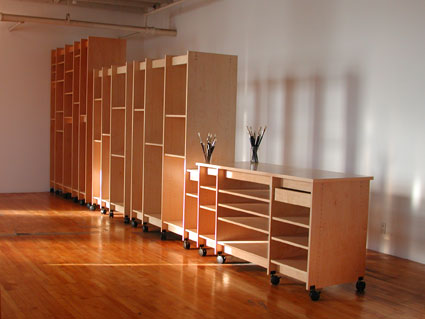
Vertical and horizontal shelving
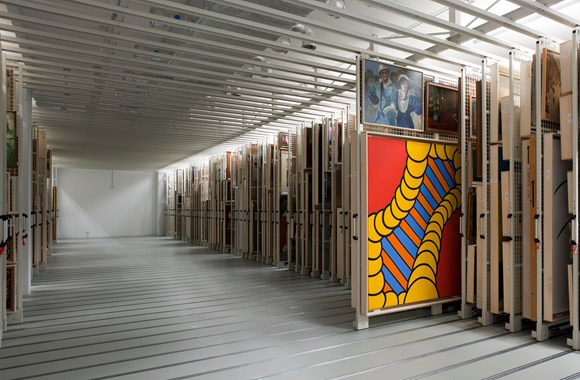
Sliding screens (Stedelijk Museum)
|
|
Your artwork can last a lifetime and be enjoyed by generations after, but it all starts with the proper maintenance and storage of your collection, today!
This article was made possible with files from the CCI.
If you have any questions about any of our products or services, please do not hesitate to contact us. Our knowledgeable staff are always happy to answer your inquiries and provide suggestions or advice.
|
|
© 2002-2025 - KeenART Media Ltd.
|
|
| |
|

